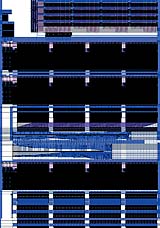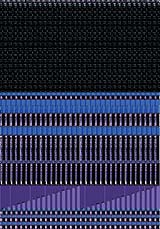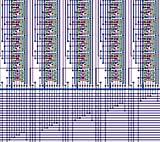
 Detail 1 |
 Detail 2 |
 Detail 3 |
| A New Processing-in-Memory
Chip Jay B. Brockman, associate professor of computer science and engineering, and graduate student Shyamkumar Thoziyoor are finalizing the design of a Processing-in-Memory (PIM) chip for use in a new generation of computers. Members of the Notre Dame PIM team, Brockman and Thoziyoor are collaborating with researchers from the California Institute of Technology and NASA’s Jet Propulsion Laboratory to develop massively parallel computer systems using PIM technology for applications including finite-element analysis, molecular dynamics, astrophysics, and data mining. The chip will be fabricated by the Metal Oxide Semiconductor Implementation System (MOSIS) in August 2003 using 0.18 micron technology. The fine lines and densities which can be achieved using this state-of-the-art silicon lithography process is necessary to support high-performance processing and high-capacity data storage. Founded by the Defense Advanced Research Projects Agency in 1981, MOSIS is a low-cost, small-volume prototyping production service for VLSI circuit development. It has fabricated more than 50,000 circuit designs for academic institutions, governmental agencies, and commercial firms since its inception. The key feature of the PIM design is that it places a custom microprocessor and main memory on the same chip, eliminating one of the major bottlenecks in conventional computer systems. The chip will hold four independent PIM units, similar to Detail 1. The dense area at the top of Detail 2 is the “memory,” and the processors, in blue, are segmented in columns to align with the memory. Each horizontal band is a step in the processing pattern. Detail 3 highlights the permutation network located in the triangular sections shown on Detail 2. The permutation network rearranges the order of data as it is accessed from memory. Although the chip will run at clock speeds slower than today’s fastest commodity microprocessors, it will be capable of performing many operations in parallel, leading to higher performance for many scientific and engineering applications. |
||